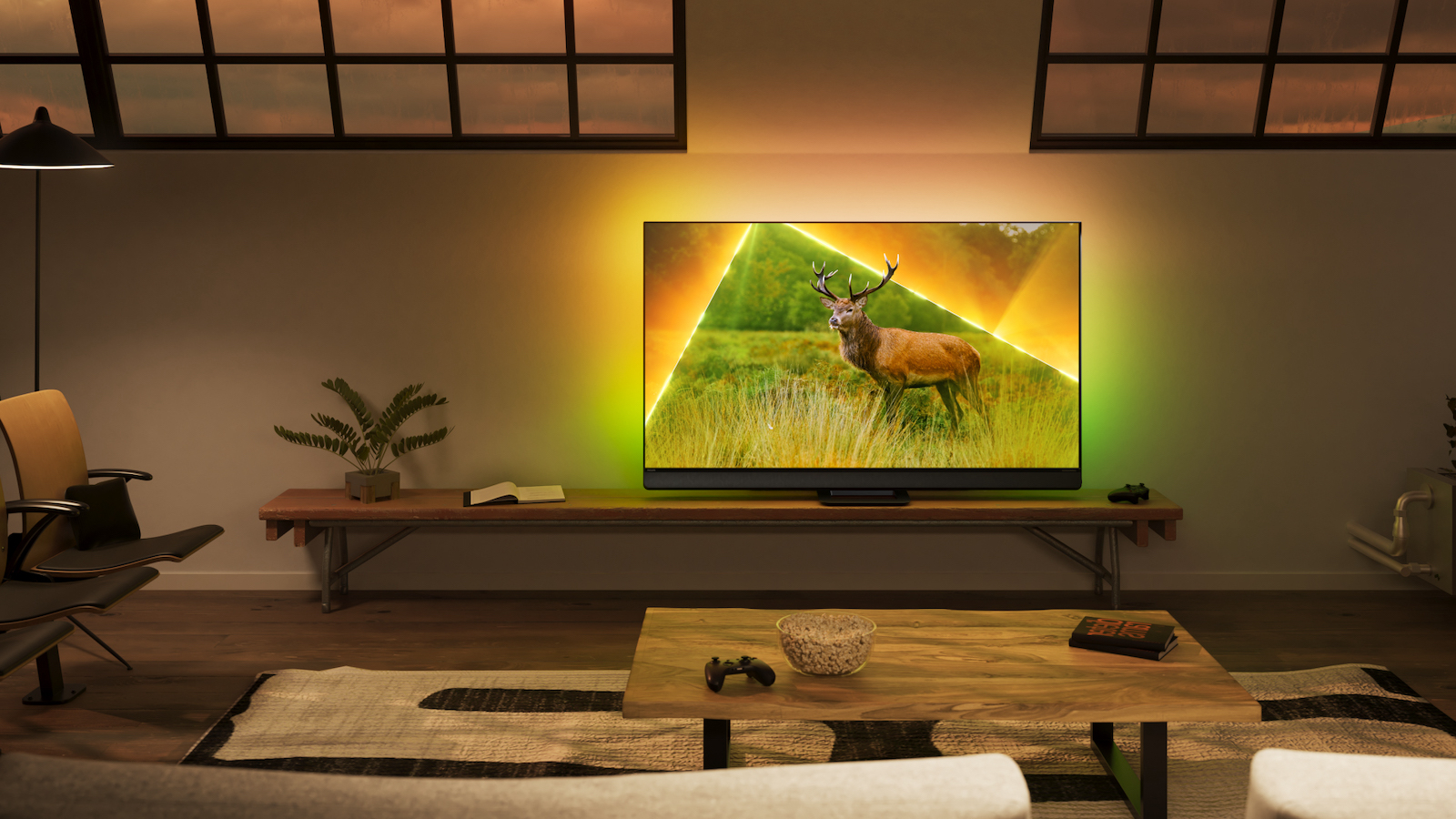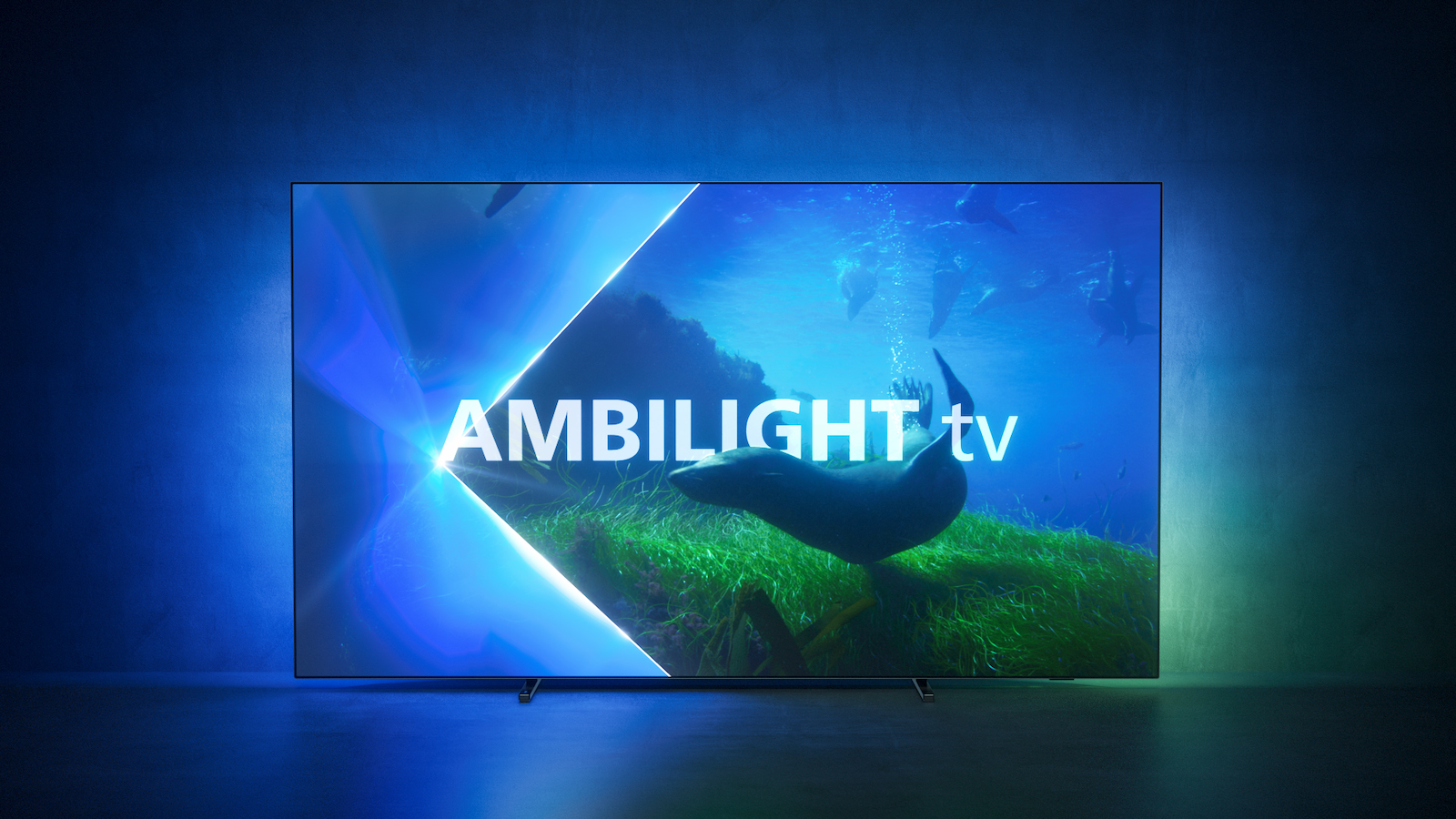There’s no TV like a Philips Ambilight TV
The new premium Philips Ambilight TV range has a model for everyone

There’s a huge amount to consider when hunting for a premium TV. Naturally, you want the best picture quality, but should you go for an OLED, Mini LED or LED model? How important is sound quality? Which HDR formats do you need and are all of the gaming features covered?
Well, Philips TV has new premium OLED, Mini LED and LED models that all boast superior sound, handle every current HDR format and support all of the latest and greatest gaming features, including Dolby Vision gaming. What’s more, all of these models also have a feature you won’t get from any non-Philips TVs – Ambilight.
The Ambilight difference

For those yet to experience the unique joy of Ambilight, allow us to explain. Ambilight is a series of LEDs positioned on the rear of the TV facing upwards and out to the sides. These LEDs can be set to provide bias lighting that reduces eye strain and increases perceived contrast, but the Ambilight system is even better when it’s set to dynamically follow whatever you are watching, extending the action onto the wall around the TV as coloured light.
Yes, Ambilight looks amazing, but there’s more to it than sheer spectacle. As mentioned, it can increase perceived contrast, making blacks look even deeper, but by extending the on-screen action to the wall it also makes the TV seem larger than it is. It’s like going up a size without having to pay for it.
Philips TV’s new OLED808 and OLED+908 OLEDs, the PML9308 Mini LED model and PUS8808 LED TV all in fact feature Next-Gen Ambilight. This incorporates brighter LEDs that can handle an even greater range of colours and can be controlled individually, resulting in a more thrilling but also more accurate Ambilight experience that increases immersion in a way that other TVs can’t match.
Unique Philips TV picture processing

Even without Ambilight, these would be special TVs. A huge amount of TV performance comes down to picture processing, and Philips TV has long been one of the very best in this regard. This year, it has introduced the 7th-Gen version of its P5 AI engine, so named for its focus on the five key pillars of picture quality: colour, contrast, resolution, motion and source quality.
This 7th Gen P5 AI processor features numerous upgrades, most notably Ambient Intelligence V2, which adapts the picture not just to the amount of light in the room but also the precise tint of that light. This is vital to getting an accurate picture performance regardless of room conditions. After all, very few of us can watch movies in perfect pitch-black conditions at all times.
Then there’s the new Super Resolution feature, which is designed to make the image extra-sharp while maintaining the fine details of everything you watch. Most sharpness-boosting algorithms reduce detail, so delivering sharpness and subtlety in this way is quite the feat.
As mentioned, all of Philips TV’s premium models support all current HDR formats – HLG, HDR10, HDR10+ and Dolby Vision. The same can’t be said of any TVs for many TV brands.
Flagship Philips TV OLED models

When it comes to choosing your specific Philips Ambilight TV, it’s hard to look past the OLED808. It features a ‘Prestige’ version of the OLED_EX panel, which combines perfect blacks and pixel-level contrast control with a peak brightness of 1000 nits, and it has a 70W 2.1 sound system that will be significantly higher quality than that of most TVs in its category. The OLED808 is also the first Philips OLED TV to be available as a 42-inch model, alongside 48-, 55-, 65- and 77-inch versions.
The OLED+908 takes things even further. This features a Meta OLED panel with Micro Lens Array technology that results in a peak brightness of 2100 nits. That’s more than twice as bright as standard OLED sets, all without sacrificing those perfect OLED blacks. Viewing angles are even better from the OLED+908, and it’s more energy efficient too.
That flagship picture technology is mated to a flagship sound system developed by legendary British hi-fi brand Bowers & Wilkins. While the speaker system is subtle and classy (featuring beautiful, acoustically transparent Kvadrat fabric), it’s also powerful and technically gifted, boasting discrete left, right and centre channels, each with two midrange drivers and a titanium dome tweeter, plus a rear-mounted subwoofer with a 75mm bass driver and no fewer than four passive radiators.
Whether you go for one of these OLED models or the PML9308 Mini LED model or PUS8808 LED TV, you will find yourself in possession of a uniquely classy TV that will enhance the look of your living room. You can also be reassured that you’ve made an eco-conscious choice, as Philips TV has removed as much plastic as possible from its TVs and packaging, and uses soy-based mono inks for its boxes rather than glossy, colourful designs.
For more information, please visit: www.philips.com/tv
The latest hi-fi, home cinema and tech news, reviews, buying advice and deals, direct to your inbox.
What Hi-Fi?, founded in 1976, is the world's leading independent guide to buying and owning hi-fi and home entertainment products. Our comprehensive tests help you buy the very best for your money, with our advice sections giving you step-by-step information on how to get even more from your music and movies. Everything is tested by our dedicated team of in-house reviewers in our custom-built test rooms in London, Reading and Bath. Our coveted five-star rating and Awards are recognised all over the world as the ultimate seal of approval, so you can buy with absolute confidence.

